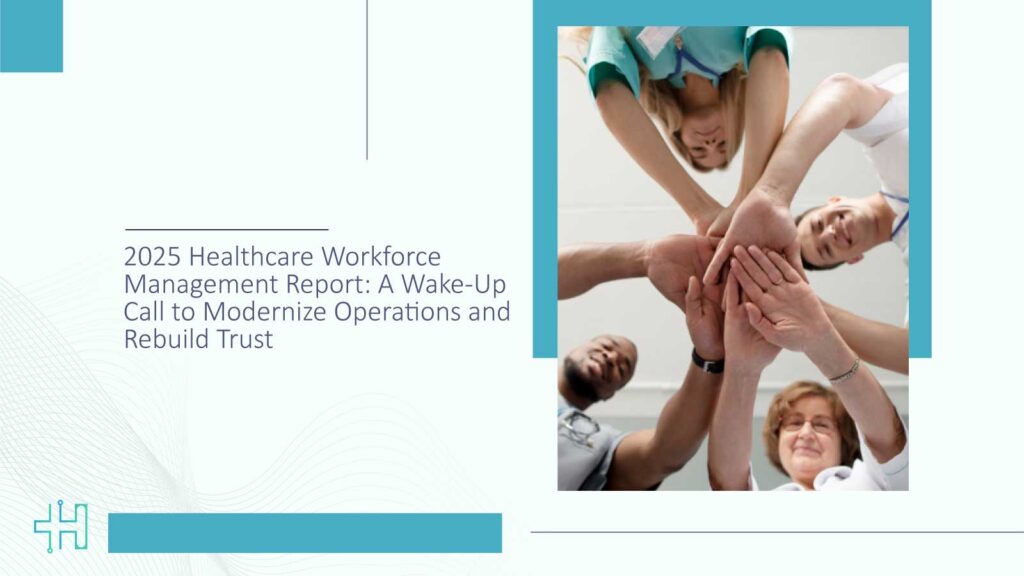Let’s talk about what’s happening inside the healthcare workforce in 2025.
The night-shift nurse isn’t sure if she’ll get the right paycheck again this week. The scheduler scrambles to fill 12 shifts with no backup. The HR director toggles between spreadsheets and sticky notes to track credentials. The administrator wants to make things better, but keeps patching holes in systems never built to handle this much strain.
The 2025 Healthcare Workforce Management Report puts data to what many have been feeling for years: healthcare’s workforce crisis isn’t just about not having enough people. It’s about outdated processes, missed paychecks, misaligned priorities, and broken trust. It’s about the weight care teams are carrying without the support they need from the systems around them.
But the report doesn’t stop at the problem. It also points to a better path, one that puts people first and uses purpose-built technology to fix the gaps that are burning teams out.
The Hidden Struggles of Healthcare Providers
The report surveyed over 650 healthcare professionals across facilities, home care, and community-based organizations. The findings are eye-opening:
- 74% of providers are dealing with active staffing shortages.
- 81% of administrators say they’re making payroll errors monthly.
- 72% of care staff say they feel burned out at least once a month.
- Only 37% of frontline workers feel satisfied in their current roles.
These aren’t just statistics. They’re signals. Signals that the systems meant to support care workers’ payroll, scheduling, compliance, and communication are falling short. And when those systems fail, so does trust.
Key Issues Affecting Healthcare Team Efficiency
Outdated systems, payroll errors, and manual workflows are quietly draining time and energy from already stretched teams. When basic operations break down, even the most committed staff struggle to keep up.
1. Payroll Errors That Break Trust
Healthcare pay is complex differentials, overtime, and per-visit rates. But generic payroll systems weren’t designed to handle this. The result? Over 80% of care staff say three payroll mistakes a year are enough to lose trust in their employer. Some say one is too many.
2. Misalignment Between Pay and Retention
Care staff overwhelmingly say pay is their top motivator (75%). But only 37% of administrators believe that. That disconnect? It’s causing people to leave for roles that offer better financial security, even if they’d prefer to stay.
3. Compliance Fatigue and Risk
With over 600 changing compliance requirements, most teams are struggling to keep up. Only 9% of administrators say they proactively stay current. For everyone else, it’s a scramble and a risk to their organizations, licenses, and people.
4. Disconnected, Manual Systems
Most healthcare teams are still operating with a patchwork of tools: one for scheduling, one for HR, another for payroll, and spreadsheets in between. It’s slow, error-prone, and exhausting.
5. Short-Term Staffing Solutions That Add Long-Term Strain
Temporary or agency labor is a necessary bridge but not a long-term fix. It adds cost and chips away at team cohesion, leaving full-time staff feeling unsupported and stretched thin.
What Healthcare Needs Now: People-Centered Technology
This isn’t about digitizing everything for the sake of it. It’s about using the right tools to give people back their time, their trust, and their ability to focus on care, not chaos.
The report found that organizations using healthcare-specific workforce management tools saw:
- Up to 85% reductions in payroll processing time.
- Fewer compliance errors and license expirations.
- Increased trust and retention among care staff.
- Lower admin burnout.
These tools work because they’re built for healthcare’s complexity, not borrowed from another industry and forced to fit.
Four Vital Shifts for Greater Workforce Diversity
Improving healthcare work isn’t about grand overhauls; it’s about smart, practical changes that ease everyday stress. These four shifts help teams feel seen, supported, and able to focus on what matters most: caring for people.
1. Create Career Paths Worth Staying For
Most care staff want to stay in healthcare, 62% see it as their long-term path. But they’re not sure if there’s room to grow where they are. Offering career development, training, and mentorship can help rebuild loyalty.
2. Make Pay Transparent, Accurate, and Timely
Errors cost more than dollars. They cost trust. Providing itemized pay, clear bonus structures, and consistent payroll systems shows care staff they’re respected and that their time matters.
3. Automate the Right Things
From shift differentials to credential tracking, automation should simplify, not complicate. With the right tools, teams can focus less on admin work and more on the work that truly matters: caring for patients.
4. Embrace Compliance for Lasting Success
When compliance tracking is proactive, it creates peace of mind for staff, leaders, and patients. Using technology to stay ahead of audits and certifications reduces risk and builds a culture of accountability, not anxiety.
Healthcare Runs on People
Behind every shift logged, every patient cared for, and every form filed, a person is holding the system together. A nurse trying to stretch a short-staffed team. A scheduler fielding last-minute absences. An HR lead double-checks license renewals at 10 p.m. because the system didn’t remind them. We talk a lot about the future of healthcare. But here’s the truth: that future depends on whether we take care of the people who are carrying it right now.
The 2025 Healthcare Workforce Management Report isn’t just a collection of stats; it’s a mirror. It reflects the strain so many in healthcare are feeling, but it also points to a better way forward. A way where trust is built through accurate paychecks, where burnout is addressed with smarter systems, and where compliance isn’t a crisis, it’s just part of how things work.
This is our moment to stop patching the cracks and start rebuilding the foundation. Not with more pressure. But with more clarity, more support, and more compassion for the teams that make healthcare happen.
FAQs
1. What makes healthcare payroll so prone to errors?
Because it’s complicated, shift rates, licenses, overtime, and multi-site rules all collide. Most systems weren’t built for this, and that leads to mistakes that hurt trust.
2. How do I know if my systems are part of the problem?
If your team is juggling spreadsheets, fixing repeated errors, or always playing catch-up, you’re likely dealing with system strain, not just staffing issues.
3. Isn’t burnout just about long hours?
Not always. Broken systems like late pay, missed credentials, or clunky schedules add daily stress. Over time, that’s just as draining as long shifts.
4. Is healthcare-specific tech only for big hospital systems?
Nope. Many modern tools are built for smaller organizations, home care agencies, clinics, and senior living facilities. You don’t need to be big to benefit from smarter systems.
5. What’s the first thing I should do after reading the report?
Ask your team what’s not working. Then match their answers to the report’s insights. You’ll find clear, doable places to start improving.
Dive deeper into the future of healthcare.
Keep reading on Health Technology Insights.
To participate in our interviews, please write to our HealthTech Media Room at sudipto@intentamplify.com




